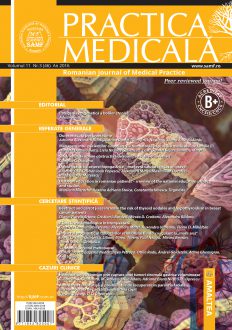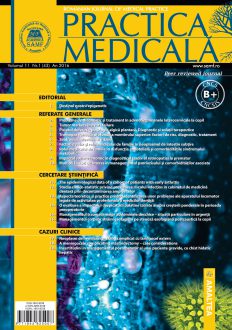SELECT ISSUE

Indexed

| |

|
|
|
| |
|
|
|

|
|
|
|
|
|
|
HIGHLIGHTS
National Awards “Science and Research”
NEW! RJMP has announced the annually National Award for "Science and Research" for the best scientific articles published throughout the year in the official journal.
Read the Recommendations for the Conduct, Reporting, Editing, and Publication of Scholarly work in Medical Journals.
The published medical research literature is a global public good. Medical journal editors have a social responsibility to promote global health by publishing, whenever possible, research that furthers health worldwide.
Menopausal status and severe pathological conditions: is there a place for bone and neuroendocrine markers?
Dan Nicolae PADURARU, Adina GHEMIGIAN, Adriana Elena NICA, Ana VALEA and Mara CARSOTE
ABSTRACT
Introduction. Menopause involves skeletal losses, which may be accelerated by breast cancer and associated therapy, as aromatase inhibitors.
Case presentation. A 67-year old Caucasian female underwent 2 years ago a right mastectomy for breast cancer (invasive ductal carcinoma of mucinous type; 85-90% positive reaction of estrogen receptor). Synchronously, she presented, at computer tomography, a left adrenal hyperplasia, stationary during follow-up. Tamoxifen was continued for two years, then a switch to anastrozole was done for the last four months. On admission, the assays showed a non-secretor adrenal pattern, with negative neuroendocrine markers, including serum serotonin. Bone profile pointed mild hypercalcemia with normal parathormone levels, as well as bone turnover markers and 25-hydroxyvitamin D (negative imagery scan for bone metastases). Dual-Energy X-Ray Absorptiometry (DXA) revealed osteopenia with a mid deterioration of Trabecular Bone Score (TBS) at 1220. Further continuation of aromatase inhibitor is recommended, in association with vitamin D supplementation and monthly oral risendronate, good hydration and serial calcium assays.
Conclusion. Modern approach of menopausal breast cancer with aromatase inhibitors increases the speed of age-related bone loss, while detailed imagery may find otherwise unknown artefacts as non-tumour enlargement of adrenal glands. Whether neuroendocrine markers like 5-hydroxytryptamine will find a place in this particular context, apart from traditional bone indices, is still difficult to establish.
Keywords: breast cancer, osteopenia, serotonin
Full text | PDF


